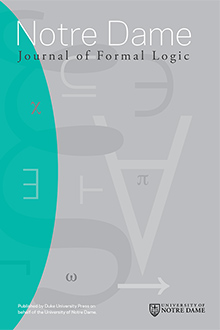During the Notre Dame workshop on Vaught's Conjecture, Hjorth and Kechris asked which Borel equivalence relations can arise as the isomorphism relation for countable models of a first-order theory. In particular, they asked if the isomorphism relation can be essentially countable but not tame. We show this is not possible if the theory has uncountably many types.
References
[1] Dougherty, R., S. Jackson, and A. S. Kechris, "The structure of hyperfinite Borel equivalence relations", Transactions of the American Mathematical Society, vol. 341 (1994), pp. 193--225. MR1149121 0803.28009 10.2307/2154620[1] Dougherty, R., S. Jackson, and A. S. Kechris, "The structure of hyperfinite Borel equivalence relations", Transactions of the American Mathematical Society, vol. 341 (1994), pp. 193--225. MR1149121 0803.28009 10.2307/2154620
[2] Feldman, J., and C. C. Moore, "Ergodic equivalence relations, cohomology, and von Neumann algebras. I", Transactions of the American Mathematical Society, vol. 234 (1977), pp. 289--324. MR0578656 0369.22009 10.2307/1997924[2] Feldman, J., and C. C. Moore, "Ergodic equivalence relations, cohomology, and von Neumann algebras. I", Transactions of the American Mathematical Society, vol. 234 (1977), pp. 289--324. MR0578656 0369.22009 10.2307/1997924
[3] Hjorth, G., Classification and Orbit Equivalence Relations, vol. 75 of Mathematical Surveys and Monographs, American Mathematical Society, Providence, 2000. MR1725642 0942.03056[3] Hjorth, G., Classification and Orbit Equivalence Relations, vol. 75 of Mathematical Surveys and Monographs, American Mathematical Society, Providence, 2000. MR1725642 0942.03056
[4] Kechris, A. S., Classical Descriptive Set Theory, vol. 156 of Graduate Texts in Mathematics, Springer-Verlag, New York, 1995. MR1321597 0819.04002[4] Kechris, A. S., Classical Descriptive Set Theory, vol. 156 of Graduate Texts in Mathematics, Springer-Verlag, New York, 1995. MR1321597 0819.04002
[5] Knight, J., and M. Nadel, "Expansions of models and Turing degrees", The Journal of Symbolic Logic, vol. 47 (1982), pp. 587--604. MR666818 0527.03013 10.2307/2273590 euclid.jsl/1183741088
[5] Knight, J., and M. Nadel, "Expansions of models and Turing degrees", The Journal of Symbolic Logic, vol. 47 (1982), pp. 587--604. MR666818 0527.03013 10.2307/2273590 euclid.jsl/1183741088
[6] Knight, J., and M. Nadel, "Models of arithmetic and closed ideals", The Journal of Symbolic Logic, vol. 47 (1982), pp. 833--40. MR683158 0518.03032 10.2307/2273102 euclid.jsl/1183741142
[6] Knight, J., and M. Nadel, "Models of arithmetic and closed ideals", The Journal of Symbolic Logic, vol. 47 (1982), pp. 833--40. MR683158 0518.03032 10.2307/2273102 euclid.jsl/1183741142
[7] Macintyre, A., and D. Marker, "Degrees of recursively saturated models", Transactions of the American Mathematical Society, vol. 282 (1984), pp. 539--54. MR732105 0557.03046 10.2307/1999251[7] Macintyre, A., and D. Marker, "Degrees of recursively saturated models", Transactions of the American Mathematical Society, vol. 282 (1984), pp. 539--54. MR732105 0557.03046 10.2307/1999251
[8] Wilmers, G., "Minimally saturated models", pp. 370--80 in Model Theory of Algebra and Arithmetic (Proceedings of the Conference, Karpacz, 1979), vol. 834 of Lecture Notes in Mathematics, Springer, Berlin, 1980. MR606795 0463.03017 10.1007/BFb0090175[8] Wilmers, G., "Minimally saturated models", pp. 370--80 in Model Theory of Algebra and Arithmetic (Proceedings of the Conference, Karpacz, 1979), vol. 834 of Lecture Notes in Mathematics, Springer, Berlin, 1980. MR606795 0463.03017 10.1007/BFb0090175





